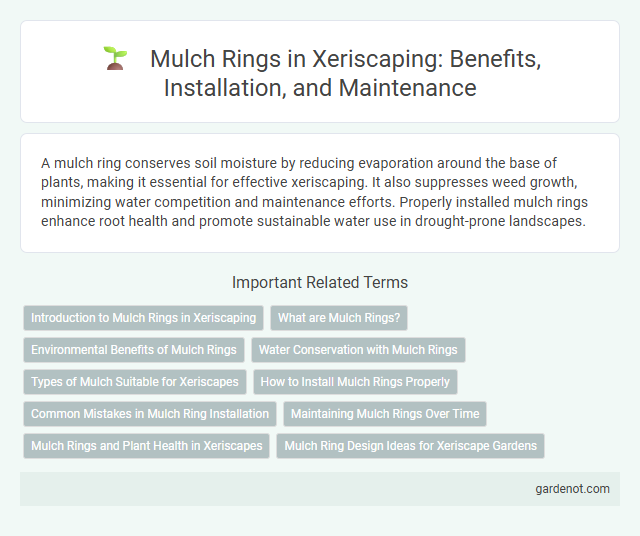A mulch ring conserves soil moisture by reducing evaporation around the base of plants, making it essential for effective xeriscaping. It also suppresses weed growth, minimizing water competition and maintenance efforts. Properly installed mulch rings enhance root health and promote sustainable water use in drought-prone landscapes.
Introduction to Mulch Rings in Xeriscaping
Mulch rings in xeriscaping play a vital role in water conservation by retaining soil moisture and reducing evaporation around plants. These rings, typically made from organic materials like bark, wood chips, or compost, also help suppress weeds and moderate soil temperature. Properly applied mulch rings enhance plant health and contribute significantly to sustainable, low-water landscaping practices.
What are Mulch Rings?
Mulch rings are circular layers of organic or inorganic material applied around the base of plants, especially trees, in xeriscape landscaping to conserve soil moisture and suppress weeds. These rings improve soil structure by regulating temperature fluctuations and enhancing water infiltration, essential for drought-resistant gardening. Properly maintained mulch rings reduce irrigation needs and promote healthier plant growth in arid environments.
Environmental Benefits of Mulch Rings
Mulch rings conserve soil moisture by reducing evaporation, minimizing the need for frequent irrigation in xeriscape gardens. They suppress weed growth, limiting competition for water and nutrients while enhancing soil health through organic matter decomposition. By stabilizing soil temperature and preventing erosion, mulch rings contribute to sustainable water-efficient landscaping practices.
Water Conservation with Mulch Rings
Mulch rings play a crucial role in water conservation by reducing evaporation around plant roots and maintaining soil moisture in xeriscape gardens. By creating a protective barrier, mulch rings help regulate soil temperature and minimize water runoff, enhancing overall irrigation efficiency. Proper application of organic or inorganic mulch rings supports sustainable landscaping by promoting deeper root growth and reducing the frequency of watering.
Types of Mulch Suitable for Xeriscapes
Organic mulches such as wood chips, bark, and composted leaves are ideal for xeriscape gardening, as they retain moisture and improve soil quality without requiring frequent watering. Inorganic options like gravel, decomposed granite, and lava rock provide excellent weed control and prolonged moisture retention, perfectly complementing drought-tolerant plants. Selecting the right mulch type enhances water conservation and supports the sustainability of xeriscape landscapes.
How to Install Mulch Rings Properly
To install mulch rings properly in a xeriscape garden, first measure a 2 to 3-foot diameter around the base of each plant to ensure adequate coverage without touching the trunk. Clear the area of weeds and grass, then lay down a 2 to 3-inch layer of organic mulch such as bark, wood chips, or compost to retain moisture and reduce evaporation. Maintain the mulch ring by replenishing the material annually and preventing it from piling directly against stems to avoid rot and promote healthy root growth.
Common Mistakes in Mulch Ring Installation
Common mistakes in mulch ring installation include applying mulch too close to the tree trunk, which can lead to moisture buildup and trunk rot, and creating mulch piles that are too thick, restricting oxygen flow to the roots. Using improper mulch types that retain excessive water or fail to decompose effectively can also harm plant health. Proper spacing of mulch rings, generally 2-4 inches away from the trunk and maintaining a 2-3 inch mulch depth, promotes tree vitality while conserving water in xeriscape landscapes.
Maintaining Mulch Rings Over Time
Maintaining mulch rings in xeriscape gardens involves regularly replenishing mulch to preserve moisture retention and temperature regulation for drought-tolerant plants. Periodic inspection prevents mulch from encroaching on plant stems, reducing the risk of rot and pest infestations. Effective mulch ring care supports soil health and promotes sustainable water conservation in xeriscaping landscapes.
Mulch Rings and Plant Health in Xeriscapes
Mulch rings in xeriscapes play a crucial role in preserving soil moisture and regulating temperature around plants, which significantly enhances plant health and drought resistance. By reducing evaporation and suppressing weed growth, mulch rings create a stable environment for root development and nutrient absorption. Proper application of mulch rings around xeriscape plants is essential to optimize water efficiency and support sustainable xeric gardening practices.
Mulch Ring Design Ideas for Xeriscape Gardens
Mulch ring design ideas for xeriscape gardens emphasize water conservation and weed control by creating a dense, protective layer around plants. Incorporate organic materials like bark chips or gravel to enhance moisture retention and soil temperature regulation in arid landscapes. Strategic placement of mulch rings around drought-tolerant shrubs and succulents optimizes water efficiency and supports sustainable xeriscaping practices.
Mulch ring Infographic

 gardenot.com
gardenot.com